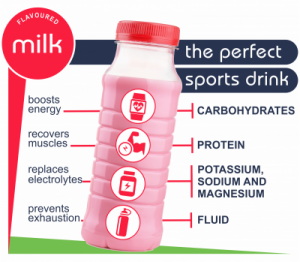Flavoured milk can make a vital difference to your child’s health and sporting performance
Parents want the best for their children and investing in the health of our youth is one of the most important things we can do to ensure the future of our nation. To be healthy, children and adolescents need to eat a varied, balanced diet and do plenty of exercise every day. Milk and dairy products are a source of nine important nutrients, including calcium, potassium and protein,1,7 and are among the most important foods and drinks for youth.
Ironically, milk (full-cream, low-fat, flavoured, or plain) and dairy products are usually not found in tuck shops or included in lunchboxes. Milk and dairy products are often also among the first items young girls start to avoid when they want to lose weight, “because they are fattening!” Unfortunately, these young, growing women then replace the milk in their diets with carbonated cold drinks.
Recently, researchers in the USA also found that the food and drinks available at youth sporting events are unhealthy.5 High-fat, high-sodium fast foods and snacks, and cold drinks and sports drinks were the most popular choices of young people. However, the general composition of sports drinks, which includes sugars, electrolytes such as sodium and potassium, and water, is not suitable for growing children.4
Research has shown that both the unavailability of nutritious drinks at schools and the avoidance of milk and dairy products are recipes for disaster. Drinking sweetened cold drinks increases energy intake and is regarded as one of the main causes of rampant childhood obesity and diabetes.4 Among young women who choose carbonated cold drinks, and particularly physically active girls, the risk of brittle bones and bone fractures are 3–7 times greater than with drinking beverages such as flavoured milk, which contains high levels of calcium in a protein matrix.1
Flavoured low-fat milk contains all the vital nutrients found in full-cream milk, but with a reduced fat content.3 Studies have indicated that, although sweetened, it can be used successfully to help young people achieve the recommended three servings of dairy a day, without boosting their energy intakes unnecessarily.1,6 By making flavoured milk available at tuck shops, training sessions and sporting events, many nutritional problems among our youth can be avoided while still offering them a pleasant-tasting, top-notch sports drink.2
To ensure the health of future generations, parents, teachers and coaches should unite in teaching children of all ages to select nutrient-rich foods. To achieve this goal, nutrition must become part of education and youth sports programmes.5 Be proactive: tell learners about the benefits of dairy products such as flavoured low-fat milk and make such products available at school tuck shops and on the sports field.
Visit us on www.rediscoverdairy.co.za
Facebook:https://www.facebook.com/dairygivesyougo/
Email: info@dairy.co.za
Tel: 012 991 4164
Fax: 012 991 4164
References:
- US Department of Agriculture, Agricultural Research Service. 2008. National Nutrients Database for Standard Reference. Release 21.
- Consumer Education Project of Milk SA. 2011. Sport nutrition & the role of dairy. Brochure published.
- Harvard Health. 2009. Carbonated beverages and the risk of bone fractures in teenaged girls. https://www.health.harvard.edu/thg/thgupdate/s/s2.shtml#bones.
- Story M, Klein L. 2012. Consumption of sports drinks by children and adolescents. A Research Review. Published by the Robert Wood Johnson Foundation.
- Thomas M, Toben F N, Harwood E, Neumark-Sztainer D. 2012. Exploring parent perceptions of the food environment in youth sport. Journal of Nutrition Education & Behavior. 44(4):365-371.
- Murphy MM, Douglas JS, Johnson RK, et al. 2008. J Am Diet Assoc. 108: 631-639.
- American Dietetic Association. 2004. J Am Diet Assoc. 104: 255.


